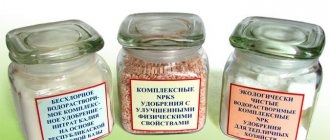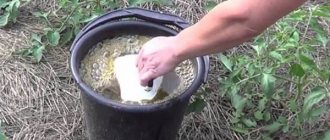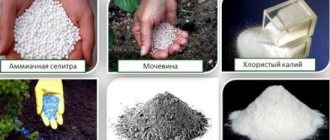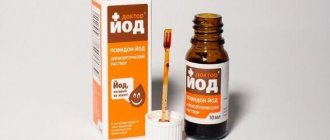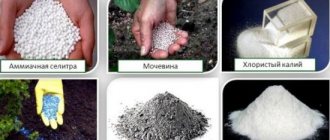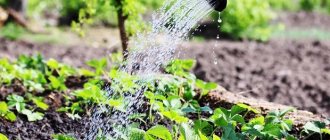Yeast feeding - as a fertilizer for plants
Yeasts are the simplest single-celled fungi. Their composition itself lacks nitrogen, phosphorus, potassium, that is, those important microelements necessary for normal plant growth. But once in the soil, they begin to affect the organic residues that are in the ground. They begin to process them, thereby decomposing these residues faster and better. When decomposed, they release large quantities of nitrogen and phosphorus into the soil.
Plants accordingly absorb the increased content of these elements and actively develop. Nitrogen helps build up vegetative mass, and phosphorus promotes better development of the root system. Here is the effect of their use. That is why such fertilizer is considered a growth stimulator. And it’s not for nothing that the following expression appeared: “It’s growing by leaps and bounds.”
The benefits of yeast fertilizer
Before fertilizing flowers, berries or vegetable crops with yeast, you need to thoroughly study the positive effect of fertilizing on vegetation:
- endurance, resistance to various diseases and adverse environmental influences appears;
- the root system is strengthened, root formation is activated;
- the growth of shoots, leaves, buds is stimulated;
- the number of beneficial microorganisms in the soil increases;
- gas exchange in the upper layers of the soil improves.
The rich composition of yeast nourishes the soil, activates microflora and has a better effect on the growth and productivity of garden crops.
How to use yeast to feed plants in the garden
Fertilizer has a lot of useful properties, namely:
- Stimulates vegetative growth of plants;
- Improves the soil, that is, enriches it with beneficial bacteria;
- The root system becomes more powerful;
- The endurance of plants improves and their immunity to adverse weather conditions increases;
- The survival rate of any seedlings improves.
Yeast requires warm temperatures for normal functioning. Therefore, fertilizing is used on warm days when the soil is sufficiently warm. If the air temperature decreases, the ground temperature also decreases accordingly, just like in rainy weather. Beneficial mushrooms will not work in such an environment, so the use of fertilizer in such weather conditions will be completely useless. But on warm, hot days, feeding warm soil will be just the thing.
And one more important point. Keep in mind that potassium and calcium must be added to the soil. Because when yeast is added, these elements are absorbed from the soil. As a result, the plant will lack these elements. And the simplest remedy that will help compensate for the loss of these elements is wood ash, since it contains both potassium and calcium.
Advantages and disadvantages
Due to the ideal composition of yeast, the product has a number of useful qualities. They provide the plant with vitamins and minerals, and in addition:
- reduce susceptibility to diseases, fungal spores, pests;
- promote accelerated development of the root system, foliage and stem;
- increase the endurance of plants that lack sunlight and light (indoor flowers, crops planted in the shade of trees);
- help accelerate the decomposition of organic matter. At the same time, more nitrogen and phosphorus are released;
- enrich the soil with amino acids and microelements.
The price of yeast is low and the consumption is low. This makes the product accessible to all categories of agricultural enthusiasts.
The negative aspects of using yeast tincture or mixture are insignificant in comparison with the positive properties. Thus, experienced gardeners have learned in practice that the frequency of applications should not be more than 3 times a season.
There is no potassium in the composition, which means that sooner or later, depletion of the soil will occur. But this problem can be solved: you need to add ash or wood. The use of a pure substance was also considered a disadvantage. It is best to use recipes that include additives: herbs, bread, milk and other ingredients.
How to prepare yeast nutrition
Anyone can prepare fertilizer for plants using yeast, since the process is simple and inexpensive. You can use not only raw yeast, but also the product in the form of a dry powder. Summer residents prefer to prepare fertilizer in the form of a liquid solution, because this form of fertilizing is easier to apply to the soil. We invite you to familiarize yourself with the most popular recipes for yeast fertilizer.
From dry concentrate
Yeast nutrition can be prepared from any concentrate that is sold in a regular grocery store. You will need to mix 100 grams of yeast powder and 2 tablespoons of regular sugar. All this should be combined with water (10 liters). After this, you need to leave the solution to brew for 2-3 hours so that the yeast is completely dissolved in the liquid. And now the finished starter should be diluted again in 50 liters of water. Feeding for flowers and seedlings is ready.
There is a simpler method of preparing a solution for feeding plants with yeast. You just need to dilute one tablespoon of dry concentrate in one bucket of water and let it brew. This fertilizer is much weaker than the previous one, but at the same time it is more gentle on plants. Sugar in such recipes is a kind of catalyst and it is this that enhances the overall effect of such a solution.
From raw
Many summer residents also use another recipe, for which you need to take only 100 g of raw yeast. This volume must be added to a bucket of water and stirred thoroughly. The water must be warm, but this fertilizer must be allowed to brew for 24 hours before use.
Using yeast in the garden
Currently, there is a strong emphasis in agriculture on developing biological methods of plant protection as alternatives to chemical methods, and yeast is an excellent alternative. They are widely used in gardening, mainly in small private gardens, by summer residents and gardening enthusiasts. as a strengthening fertilizer, for spraying plants against fungal diseases.
The positive effects of yeast fertilizer are as follows:
- stimulate root growth;
- accelerate plant growth;
- influence the density of leaves and flowers;
- yeast fungi colonize the roots, grow symbiotically with them, protecting the root system from harmful microorganisms.
For proper development, plants need, in addition to water and light, the required amount of nutrients. An easy way to provide nutrients to your plants is to use convenient, ready-to-use mineral fertilizers. However, in addition to the advantages, mineral fertilizers have disadvantages. Although this is quick and easy, it can lead to over-fertilization of plants and the formation of unfavorable changes in the soil (soil salinization).
The use of mineral chemical fertilizer complexes is especially risky when growing greens (dill, parsley, celery), vegetables that easily accumulate chemical compounds and then release harmful chemicals into our body.
An environmentally friendly solution is the use of organic or natural fertilizers, which are safer for plants (it is difficult to overdose them) and the people who eat them. They should be used primarily when growing vegetables and herbs, so that excess chemical compounds will not reach our tables with the harvest.
One of the ways to naturally fertilize plants is to use yeast. This may seem a little strange because yeast is mostly associated with bread, baked goods, and wine, but it can have uses in the garden. Yeast is a simple fungus that eats sugar. It is a widely used culinary microorganism, more specifically a single-celled fungus. Grocery stores commonly sell baker's yeast, which can be used for both fertilization and plant protection.
Brewer's yeast is characterized by a high content of readily available proteins and vitamins, therefore, after its use in the brewing process, its remains are often used to produce highly nutritious feed for farm animals. Nutritional yeast is an inactivated mushroom sold in flake or powder form that is very popular among vegetarians as a source of protein, iron, and B vitamins.
Yeast is rich in many substances useful for plant development as a nutritional supplement; it contains:
- vitamins (especially group B);
- minerals (potassium, magnesium, calcium, phosphorus);
- carbohydrates;
- valuable microelements (selenium, chromium, sodium, zinc, iron);
- proteins, amino acids (breaking down, these compounds provide the nitrogen necessary for plants).
How do yeast preparations act as a means of protecting plants from diseases:
- One of the mechanisms of action of yeast is its competition with other fungi for nutrients.
- They produce a metabolic product: ethyl alcohol - a substance with strong fungicidal and bactericidal effects. Ethyl alcohol can have a strong effect on pathogenic microorganisms that attack crops. Therefore, yeast-based preparations can be an excellent alternative to known chemical methods for protecting crops.
- The use of yeast preparations and infusions is safe, because it is a completely biological, biodegradable product.
- Yeast is also a type of mycorrhiza for plants (related to fungi) and helps roots absorb valuable nutrients from the soil.
- Baker's yeast can be used as a spray for processing vegetables, strawberries, and flowers. The solution is sprayed mainly on the leaves, and also as a comprehensive means of protection by spraying the entire plant. This is an excellent alternative to chemical pesticides and mineral fertilizers.
What plants can be fertilized with yeast?
Mostly, gardeners use yeast mixtures to saturate the soil when growing:
- tomatoes, cucumbers, peppers, carrots, radishes;
- Strawberry wild-strawberry;
- garden petunia;
- indoor geranium.
The application of fertilizers, even with such excellent properties as yeast, should be treated with caution. A single formula for care and cultivation does not work for all plants.
Do not saturate the soil with this component if it grows: onions, potatoes, garlic. If this important nuance is not taken into account, the crop will be unsuitable for long-term storage.
Below is a table with the preparation standards and rules for using this product for the most popular cultivated plants.
| Vegetable crop | Preparation and application of fertilizer |
| Tomatoes | Dissolve 100 grams of the dry variety (10 sachets) and 2 tablespoons of sugar in a ten-liter container with warm water. Let it ferment for no more than a couple of hours. Mix the stock solution 1 to 5 with clean water. Consumption rate – 500 ml per 1 bush. Apply three times: after transplanting seedlings into the ground, after rooting and before flowering |
| cucumbers | Dilute 10 grams of dry yeast in a liter of water, add an additional 50 grams of sugar. Leave for a couple of hours. Add another 9 liters of water. Let it brew for a few more hours. Dilute 1 to 5 and feed the plants |
| Eggplant | Mix 100 grams of yeast, 10 liters of water, half a liter of ash infusion, the same amount of chicken manure infusion and 3 tablespoons of sugar. Consumption rate – 2 l per 1 bush |
| Strawberry | Mix 1 kg of fresh product in 5 liters of water. Insist for a day. The standard for preparing the working solution is: 0.5 liters of starter per 7 liters of water. Consumption rate – 0.5 l per 1 plant |
| Peppers | Mix 5 liters of water, 50 grams of fresh yeast, 250 ml of chicken manure infusion, 250 ml of ash infusion and 2 tablespoons of sugar. The solution is enough for 3 plants |
| Cabbage | Mix 3 liters of water, a packet of baker's yeast from the grocery store and 100 grams of granulated sugar. Leave for 5-7 days. To prepare the working solution, mix a glass of the resulting dough and 10 liters of water. Fertilize three times throughout the entire season. |
How to apply fertilizer correctly
Tomatoes and cucumbers are fed for the first time when the seedlings have 2-3 leaves. Then before flowering. It is especially useful to add additives before flowering.
Rules and recommendations:
- Before watering with nutrient liquid, the soil must be moistened and then loosened.
- Nutrition is applied to the root zone or irrigated using a sprayer. You need to spray the stem and the outside of the leaf, not forgetting the inside.
- It is better to use the nutrient mixture in the evening, when the earth has warmed up well under the rays of the sun.
- It is also useful to feed during flowering.
- For an adult bush, pour 1-2 liters of nutrient solution at the root.
- During the season, 2-3 feedings are enough; you don’t need to “feed” more often.
Yeast water does not work when applied to cold soil. The soil should warm up to 12-15°C.
From the personal experience of gardeners: Pour 2.7 liters of settled water into a three-liter jar, add 100 g of yeast diluted in warm water, add 0.5 tbsp. Sahara. Cover with gauze and keep warm, shaking occasionally.
When fermentation ends, you will get mash. You need to take 1 glass of mash per bucket of water and pour 1 liter under each bush. Tomatoes grow powerful, healthy with lots of fruit. The main thing is that the fruits will ripen even in October. Late blight will bypass all plantings.
Another recipe from gardeners: 1 liter of warm water requires 200 g of yeast. Leave for several hours, then mix the solution with a bucket of warm water.
The following infusion will be useful for peppers: dilute 100 g of yeast in 10 liters of warm water, leave for 24 hours, feed the peppers, starting with the seedlings. And then 2 times per season is enough, especially at the beginning of flowering.
How often to water with yeast nutrition
Yeast feeding is carried out 2 times per season, no more, and only in the early stages of plant growth. It is during this period that such fertilizer is very necessary for development and will be beneficial.
The first application is carried out after the seedlings have been planted in a permanent place, and they have taken root and started to grow. During this period, seedlings for further growth urgently need nitrogen and phosphorus to build a powerful root system. It has been noticed that this helps to grow the root system 2 times more than without it or when using other fertilizers. The plants themselves look stronger because they absorb increased nitrogen content from the soil, microelements, and organic iron. And such plants will be much stronger and healthier.
The second application is carried out after 2 weeks. It would be enough. Further use will no longer be effective, since during the fruiting period phosphorus and potassium are needed more than nitrogen. The main thing here is not to overdo it, otherwise such fertilizing will give lush greenery.
Before applying fertilizer, the plants are first watered with water. The earthen lump should be moist so that the nutrients are better absorbed by the roots.
Useful properties of yeast for feeding seedlings
This baking product is rich in minerals, organic iron, as well as a whole “bouquet” of microelements.
- The formation of a developed root system is accelerated by almost two weeks due to the release of specific compounds. The power of the root system increases several times;
- yeast feeding helps seedlings tolerate insufficient lighting;
- provides seedlings with a set of B vitamins that affect the metabolic processes necessary for the full development of seedlings;
- favors the course of restoration processes;
- has a beneficial effect on the vital activity of soil microorganisms that improve soil composition;
- Yeast is also used for the growth of seedlings, because it is an active biological growth stimulant;
- yeast is rich in proteins, carbohydrates, amino acids and microelements;
- plants' resistance to diseases and pests increases;
- helps plants to withstand stress faster after picking and promotes better survival.
Experienced summer residents claim that seedlings grown using yeast are more resistant to adverse factors, they are healthier and stronger. There are many examples of higher yields and improved product quality using this baking miracle. It is yeast fermentation that allows you to achieve the necessary results.
Yeast dressing recipes
Let's look at the most interesting, in our opinion, recipes for nutrient mixtures for plants.
Standard recipe for seedlings
Dissolve 200 grams of fresh yeast in a liter of warm water. Leave the mixture to steep for 3-4 hours. Mix the resulting mother solution with water 1 to 10 and water the seedlings.
Pepper seedling mixture
Take a pack of fresh yeast weighing 100 grams and stir it in a bucket of very warm water. Cover with a lid and leave to ferment for 24 hours. After this, water the pepper seedlings.
In general, 10 liters of prepared mixture can be a lot. Therefore, prepare smaller amounts of fertilizer. For example, 30 grams per 3 liters of water.
“Tasty solution” of yeast with sugar
To make the mixture ferment better, sugar is added to it. Mix a packet of dry yeast completely in a bucket of water. Next, add 2 tablespoons of sugar and let the solution ferment for a couple of hours.
The result is a mother solution. To prepare a working solution, add 500 ml of water for every 100 ml of mother solution.
Top dressing with ash
Prepare yeast fertilizer: 100 grams of fresh product per 1 bucket of water. After this, add 0.5 liters of ash solution, 2 balls of ascorbic acid and 100 grams of sugar. The resulting mixture is infused for a day. To prepare the working solution, the resulting concentrate is mixed 1 to 10 with clean water.
Nutritional mixture with whey
Add a packet of dry yeast per liter of milk or whey. Leave to ferment for 2 hours. Then bring the volume of liquid to 5 liters (fill in 4 liters of water) and add a kilogram of crackers. The mixture is left to ferment for a week and stirred occasionally.
The working solution is prepared in the ratio of 200 ml of concentrate per 5 liters of water.
Nettle solution
This recipe is for a 70 liter container. Fill it with chopped nettles. Add half a kilo of breadcrumbs. Then add 500 grams of live yeast, 3-4 tablespoons of sugar or jam. Next, fill the water to the brim and leave it to ferment for a day.
Vitamin mixture
Recipe for 40 l. If you need less fertilizer, then reduce the amount of all components several times.
So, for 40 liters of water you need 0.4 kg of fresh yeast, 0.3 kg of ash, 2 kg of manure, a bucket of nettles or other greens.
Mix everything and leave to ferment for 15 days. Next, strain the liquid and mix it with clean water in a ratio of 1 to 10 to prepare a working solution. The liquid consumption rate is 1 liter per 1 bush (tomatoes, tomatoes, peppers, cucumbers) or 1 sq m of planting.
Infusion with potato tops
Pour half a kilo of potato tops into 5 liters of water, break and stir 100 grams of fresh yeast. Leave for 4 hours. Strain and use for foliar treatment of plants.
Iodine mixture for spraying
Mix 3 liters of whey, 100 grams of live yeast and leave to ferment for 5-6 hours. Bring the volume of liquid to 10 liters. Pour in 20 drops of iodine. Mix and spray as a prophylactic against late blight.
Solution with droppings and ash
Add 10 grams of dry product, 5 tablespoons of sugar, half a kilo of ash and droppings to 10 liters of water. Mix and leave to ferment for 3 hours. Dilute 1 to 10 to obtain ready-made fertilizer. Water the rows.
How to feed strawberries with yeast
Impressive strawberry yields are achieved using yeast fertilizers, which must be applied at least three times per season:
- during the budding period,
- at the beginning of fruiting,
- after the end of fruiting.
Take a pack of yeast weighing 100 g and dilute it with 5 liters of water. After fermentation (during the day), dilute every 0.5 liters of infusion with 10 liters of water. Apply 0.5 liters of the mixture under each strawberry bush.
Yeast creates favorable conditions for strawberry growth
Fertilizing indoor and garden flowers with yeast
Flowers, regardless of the conditions, also respond well and gratefully to the yeast saturation of the soil. The product is quickly prepared and does not require special expenses. These mixtures are used to fertilize violets, geraniums, orchids, roses, and petunias.
Usually a simple composition is used:
- Dry yeast (1 g), combine with sugar (1 tsp), heated water (1 l). After mixing the ingredients, set the container aside for several hours. The working solution is used for dilution with water 1:5 and watering plants.
- Fresh yeast (1 kg), combine with water (5 l), the resulting solution is added to 10 l of water. A good composition for feeding garden flowers.
Fertilizer for onions and garlic
Novice gardeners are wondering: is yeast water good for onions and garlic?
To fertilize garlic and onions, you can use this option: mix 10 liters of water, 15 g of dry yeast and 75 g of sugar, let it brew for 4-5 days. This is the most used option.
Terms of entry:
- The best time to fertilize onions and garlic: May and early summer. If onions are grown for greens, then a similar procedure is carried out only once, and in other cases 2-3.
- Frequent watering will deplete the soil.
- Water only when the soil is warm, otherwise there will be no benefit.
- The dosage must be observed so as not to deteriorate the taste of the product.
Fertilizer of berry crops and trees
To get good strawberry harvests, it is advisable to use yeast bait three times a season: at the first signs of bud formation; at the beginning of berry ripening; after the bushes finish bearing fruit - in the fall.
To prepare an effective fertilizer, take dry yeast (100 g), combine with heated water (5 l), and leave for 24 hours. 0.5 l of the resulting concentrate is diluted in water (10 l).
For the full development of currant bushes and excellent fruiting, prepare the following composition:
Dry substance (1 packet), dissolve in warm water (1 bucket - 10 l), add sugar (0.5 cups). Before adding the bushes, the concentrate is diluted with water in a ratio of 1:5.
When fertilizing cucumbers, it is worth remembering about grape seedlings, since the solution is ideal for both crops.
Yeast solution for mass watering in the garden
A solution in large quantities may be needed when there are many crops on the site with which yeast fertilizing is compatible.
- Pressed yeast – 100 g.
- Granulated sugar - 0.5 faceted glass.
All this is poured into a 3-liter jar, filled with warm, 20-25⁰C water, covered with gauze on top and placed in a dark place for a week to ferment. Then a glass of this infusion is poured into a bucket of water, thus obtaining a working solution for watering tomatoes, cucumbers, eggplants, carrots, cabbage and many other crops.
An exception should be made only for potatoes, onions and garlic; yeast feeding is contraindicated for them.
For each bush, this method consumes approximately 1 liter of liquid, except for strawberries and wild strawberries - for them the norm will be 0.5 liters.
A feeding solution of the same concentration can also be prepared from dry yeast:
- Dry yeast – 10 g.
- Sour milk – 1 l.
- Fermented jam – 0.5 kg.
- Dried bread – 1 kg.
All this is put into a bucket, mixed, pressed down with a press and filled with warm water. The mixture should stand in a warm, dark place for a week, during which time it should be mixed 2 times.
The working solution is made in the same way as in the case of compressed yeast: 1 cup of fermented mixture per bucket of water. Root watering.
Cucumber dressing
Yeast supplements are especially useful for cucumbers. Only the irrigation solution is prepared according to a separate recipe:
- Dry yeast – 100 g.
- Water – 10 liters.
Leave for one and a half days, water 1.5 liters per plant under the roots of the vines.
The feeding scheme should be two-stage. At the first stage, fertilizing is done in early spring, 5-6 days after planting the seedlings. When it is guaranteed to take root and after nitrogen fertilizers have been added to the soil. The fact is that Saccharomyces fungi introduced into the soil are able to absorb nitrates, thereby eliminating their presence from future fruits.
The second application of yeast to the soil is done after the plants have flowered and phosphate fertilizers have been added to the soil.
Yeast nutrition for eggplants
Although eggplants belong to the nightshade family, like potatoes, they, unlike them, can and should be watered with yeast. Any solution prepared from either pressed or dry yeast is suitable. The main thing is to add wood ash or finely ground eggshells to the soil after watering them to restore the potassium-calcium balance.
For carrots and beets
Any of their recipes is suitable for watering. The only limitation is that during the entire season the number of waterings with yeast should not be more than three.
Watering cabbage with yeast
This fertilizing not only stimulates growth, but also improves the taste of cabbage by the time of harvest in the fall. It is better to use pressed yeast, from recipe No. 1 above. You need to water cabbage with water and yeast twice a season. The last watering should be done approximately 15-20 days before harvesting the heads of cabbage from the garden. The main thing is that on the second day after watering with yeast, be sure to add wood ash to the ground: this is necessary to restore the amount of potassium and calcium needed for the growing season.
If you grow not white cabbage, but cauliflower or some other cabbage, then the concentration of yeast can be increased by 1.5-2.0 times.
Yeast for peppers and tomatoes
Any yeast recipe is suitable for watering/feeding these crops. True, there are nuances: many gardeners strengthen their compositions with special additives. For tomatoes and peppers, tobacco dust is added - but it should only be natural. If yeast irrigation is done during the formation of ovaries, then a herbal tincture should be added to the solution. And during the ripening of fruits, ash from deciduous firewood must be added to the soil.
Seedlings are watered at the rate of 0.5 liters per bush, and adult plants already require 2 liters. The first watering is done about a week after planting the seedlings, when they are guaranteed to have taken root and the initially sluggish leaves have risen and become stronger. The second is during the budding period, when tomatoes and peppers are about to bloom.
Fertilizing strawberries and wild strawberries
Yeast is added no more than three times during the entire season. With a general recommendation for such cases, which applies to all garden crops: mandatory potassium fertilizing after watering with yeast - due to their increased appetite for this mineral element.
- The first feeding is in early spring, as soon as the soil warms up to fully awaken the greenery of the bushes.
- The second - after the start of ovary growth (stage of green or white berries)
- The third is during the period of preparation for winter, after the harvest. The bulk of the ash is added at this stage.
Foliar feeding by spraying
Some manuals do not recommend such fertilizing due to the fact that the technical purity of yeast (especially pressed yeast, and made not according to GOST, but according to TU) may raise doubts. They may contain a large number of impurities in the form of yeast of the genera Candida and Torulopsis.
Not only do impurities reduce the efficiency of pressed yeast, but they can also act as pathogens on the leaves of strawberry bushes, especially considering their ability to mutate under natural conditions.
Raspberry feeding
It is used mainly by opponents of mineral fertilizers and supporters of “naturalness”. Then yeast nutrition can really serve as some kind of alternative to minerals in complex compounds.
A yeast solution for raspberries is prepared in a ratio of 1:5 according to any of the given recipes, watering is done immediately. It is not recommended to do more than two feedings. Feeding time
- The first is in early spring (late April-early May).
- The second - immediately after flowering, before the formation of berry ovaries.
Root watering, approximately 2.5 liters per bush.
Tips and tricks
Experts give a number of recommendations that gardeners and gardeners, as well as those who like to grow house flowers on an indoor windowsill, should adhere to:
- You must always remember that yeast works in warm temperatures, and therefore it is important to apply yeast-based fertilizers to warm soil;
- The product, whether raw or powdered, must always be fresh. Expired yeast cannot be used to fertilize any plants;
- You need to adhere to the recommended amount of fertilizing plants with yeast per season. Don’t overdo it, because “more” does not always equal “better”.
- It is best to combine yeast fertilization of the soil with the addition of ash. This is especially true for garden crops. Ash replenishes the deficiency of potassium and calcium that has arisen in the soil, since the latter are absorbed by yeast during fermentation.
What are the benefits of yeast
The fungi that make up yeast accelerate the decomposition of organic compounds, have a beneficial effect on soil microflora and protect plants from diseases and pests. Yeast contains proteins, carbohydrates, trace elements, minerals and B vitamins necessary for plant growth and development. This increases the seedlings’ chances of survival even in low light conditions. When dissolved in water, yeast forms compounds that accelerate the formation of the root system, and also transfers to the plant the vitamins necessary for its development and recovery.
Beginner gardeners often wonder whether it is possible to feed garden crops with yeast? Yes, they can be used to feed almost all plants:
- indoor and garden flowers,
- garden and vegetable crops,
- ornamental and berry bushes, etc.
The only exceptions are potatoes, garlic and onions.
Yeasts are resilient organisms and, unlike other fertilizers, they are not immediately washed away during precipitation. Fungi also easily tolerate high and low temperatures, pressing and crushing. The only serious enemy of these microorganisms is aggressive bacteria, which can suppress their development.
How to use it correctly
The preparation and use of yeast fertilizer compositions must be competent. You cannot overdo it when feeding vegetable beds with this folk remedy. There is a risk of soil impoverishment.
Timing and frequency
It is optimal to use the baking product to fertilize vegetable or garden plantings no more than 3 times during 1 season:
- for the first time - for better rooting of seedlings;
- the second feeding - after rooting of seedlings (increasing the solution consumption to 1 l);
- the third time is used on the eve of flowering (using 2 liters per bush).
Yeast feeding for berries
Yeast can not only improve the growing season of plants, but also relieve them from certain diseases. For example, watering with a yeast solution will help prevent the appearance of gray rot on strawberries. You can make it as follows - the bread product is diluted in the amount of 100 grams per 10 liters of water. The same solution is useful for spraying tomatoes against late blight.
Common Mistakes
Some common mistakes regarding the use of yeast feeds include:
- their use at the fruiting stage, which threatens to deteriorate the taste of the fruit and inhibit plant growth;
- the use of this fertilizing composition for crops growing in a greenhouse (there is a risk of the roots getting burns from the substance that has begun to ferment under the influence of high temperature);
- too frequent use of the product (it is not recommended to apply it more than 2-3 times per season).
